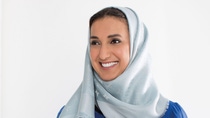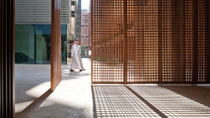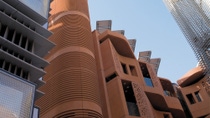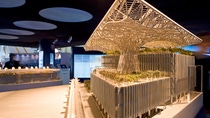Chi siamo
The diplomat of sustainability

Situated in the desert of Abu Dhabi in the United Arab Emirates (UAE), Masdar City aspires to be one of the most sustainable cities in the world. As it takes shape, Dr. Nawal Al-Hosany, Director of Sustainability at Masdar, explains this ambitious energy-saving project, and how it could serve as a role model all over the globe.
Creating Chemistry: Masdar City is growing fast. Your goal is to become a nearly zero-emissions city over the coming decades. Can you give us a short update on how successful your efforts have been so far?
Dr. Nawal Al-Hosany: Masdar City, an integrated unit of Masdar, is being built as the world’s most sustainable urban development. Several measures are being taken to ensure that it remains a low-carbon, low-waste city that can serve as a commercially viable role model for cities across the world. Masdar takes a multifaceted approach to the entire value chain of renewable energy and sustainability. Besides implementing energy efficiency measures, such as the use of recycled concrete in the construction of Masdar City, we are developing smart grids on several levels in partnership with global cleantech leaders.
Do such systems offer an opportunity for energy and cost savings?
They do in an enormous way, through an integrated grid that tracks and influences energy consumption all the way from the utility down to the consumer level. Smart appliances, meters, sensors, dashboards, building management systems and distribution management systems are all part of the integrated network. For example, Siemens’ Middle East headquarters, currently under construction in Masdar City, will meet the highest architectural and energy efficiency requirements – potentially resulting in a 45% reduction in energy consumption compared with the internationally acknowledged ASHRAE (American Society of Heating, Refrigerating and Air Conditioning Engineers) standard and a 50% reduction in water consumption.
Is construction inside Masdar City progressing well?
Yes, it is. The first completed neighborhood comprises the Masdar Institute and retail outlets including a bank, a grocery store and restaurants. The City also has a number of ongoing pilot projects. Some of the projects, for instance, encourage sustainable transportation and test the efficiency of electric vehicles, including the driverless electrical personal rapid transport system.

Dr. Nawal Al-Hosany
Director of Sustainability at Masdar City
Dr. Nawal Al-Hosany oversees the company’s corporate sustainability programs. One of the company’s projects, Masdar City, is a new development being built in Abu Dhabi, United Arab Emirates (UAE). Al-Hosany leads a team responsible for developing sustainability standards and policies in the area, which is intended to provide housing and business opportunities for 40,000 residents and 50,000 commuters, and generate minimal waste and CO2 emissions. Al-Hosany grew up in the UAE, where she also completed her engineering degree. She obtained her doctorate from the University of Newcastle upon Tyne, United Kingdom, and attended Harvard Business School in Cambridge, Massachusetts. Before her role at Masdar, she was the deputy director for planning at the Abu Dhabi Police Force – the first woman to hold this position – and in 2008, received the Emirates Business Woman Award. Al-Hosany tackles challenges in her private life as readily as she does in her work: Along with a friend, she was the first woman from the UAE to climb Mount Kilimanjaro.
Can you tell us more about the energy requirements of Masdar City?
The entire demand of Masdar City is met by power generated through the 10-megawatt photovoltaic solar power plant – the Middle East’s largest grid-connected solar power plant – and the rooftop photovoltaic panels inside the city. Any excess power is fed back into the Abu Dhabi national grid. Masdar, the company that initiated the Masdar City project, has also developed other large-scale commercial renewable energy projects, both domestically and internationally. In Abu Dhabi, the company has developed the 100-megawatt Shams One plant, one of the world’s largest concentrated solar power (CSP) plants.
The plant can help save approximately 175,000 metric tons of CO2 every year, equivalent to planting 1.5 million trees or taking 15,000 cars off city roads. Internationally, Masdar has developed the first commercial-scale 19.9-megawatt CSP plant in Southern Spain, Gemasolar, the world’s first solar power plant capable of 24-hour electricity generation. Masdar is now developing the twin 50-megawatt CSP plants Valle 1 and 2 in partnership with the Spanish development and technology group SENER. Besides solar power projects, Masdar is also developing one of the world’s largest planned offshore wind farms, London Array, in a partnership with DONG Energy and E.ON. It is also spearheading several renewable energy projects in developing countries such as Seychelles, Tonga and Afghanistan.
“Masdar City can serve as a commerically viable role model for cities across the world.”
Dr. Nawal Al-Hosany, Director of Sustainability at Masdar City
Solar energy is only one side of the story. How about other alternative energy concepts in Masdar City?
Masdar does not only develop renewable energy projects; it is a commercially-driven enterprise that operates across the full spectrum of the renewable energy and sustainable technology industry. As you know, the most sustainable option depends on each country’s resources and how abundant they are. Let us take Masdar City: We have capitalized on the plentiful solar energy available in Abu Dhabi by building a 10-megawatt solar power plant and rooftop photovoltaic panels. We also pursue an urban development approach with as little wastage and CO2 emissions as possible. The cleantech cluster embodies Abu Dhabi’s commitment to a sustainable future by pioneering the best practices in sustainable urban planning, design and construction, as well as educating residents about efficient energy usage.

How much energy does Masdar City consume compared to other cities?
Compared to the 2011 average figures in Abu Dhabi, Masdar City has managed to cut water consumption by 54%, electricity consumption by approximately 70% and cooling requirements by 50%. Waste is sorted and recycled, and organic waste will be used for compost. Masdar City also has a geothermal test site – a pilot project that involves exploratory drilling deep underground to test the availability of sufficiently hot geothermal water to be used in thermal cooling.
Early on, there was a lot of attention focused on Masdar City, but this has since died down. Is construction still on schedule?
First of all, I do not feel that it has become quieter around Masdar City: Whether locally or abroad, the interest in Masdar City’s progress has steadily increased over the years. And we have already achieved many milestones: Construction on the Masdar headquarters building and the International Renewable Energy Agency (IRENA) headquarters started last autumn and Siemens’ Middle East headquarters is scheduled for completion in 2013. When fully built by 2025, the city is expected to have 40,000 residents and welcome 50,000 commuters.

What places around the world do you consider to be the most inspiring with regard to sustainability and carbon-neutral living? Can you tell us how they influence you at Masdar?
First of all, every country has its own environmental context, but we learn from many experiences around the world, especially in regions that offer similar climatic conditions. The design elements used in Masdar were inspired by traditional Arabic architecture. For example, the wind tower inside Masdar Institute’s campus – which captures wind with its flexible flaps, directs it downwards and uses it for cooling – is a modern interpretation of one of the region’s most iconic traditional architectural features, the Al Barjeel. This was prominent in many Gulf Cooperation Council (GCC) homes. Cities that inspired Masdar City’s master plan include Shibam in Yemen, Aleppo in Syria and Marrakesh in Morocco, as well as traditional districts within Abu Dhabi and other cities in the UAE and Gulf region.

20%
Masdar City's goal is to use just one-fifth of energy consumed by a similar sized city.
0
The number of cars with combustion engines that will be allowed in Masdar City.
54%
The reduction in water use in Masdar City compared to Abu Dhabi.
2025
The year when Masdar City is due to be completed and ready to provide space for its 40,000 inhabitants.
Generally speaking, what can cities do to drive climate protection?
We can all agree that climate change is a threat that the global community shares. Rising temperatures and sea levels will have a major impact on our region and it is in our interest to find solutions. Our country is already gaining global visibility as a sustainability champion with an active role in international climate negotiations such as Rio+20. Inside Masdar City, we continue to improve energy efficiency standards in our buildings, invest in sustainable public transport and support public awareness campaigns to inform our society about how we can reduce emissions. And yes, there is no doubt that people can have a higher impact on saving energy when they have intrinsic motivation.
“I'm hoping my house will serve as a case study for all Abu Dhabi community members to identify ways in which they can implement sustainability measures in their own homes.”
Dr. Nawal Al-Hosany
How important is it for you to exchange information with experts from all over the world?
Working in Masdar City – a test bed for research, development and creation of scalable innovations in renewable energy and clean technologies for sustainable development – means that information exchange and knowledge sharing is part of our daily routine. On a personal level, I was appointed Sherpa (chief negotiator) to the U.N. Secretary General in the ‘The Sustainable Energy for All’ initiative to support the appointed principal, Dr. Sultan Ahmed Al Jaber, the Chief Executive Officer of Masdar. I also serve on the boards of several regional and international initiatives and organizations: I’m a Co-Chairperson of Women for Sustainable Growth and I was part of the Sustainable Development Dialogue panel in Rio. These are all platforms for knowledge exchange that directly add to my experience and understanding of industry’s best practice.
Do you also aim to establish platforms for knowledge exchange in Masdar City itself?
On a wider scale, Masdar City and Masdar Institute of Science and Technology are attracting leading academics, researchers and businesses eager to situate themselves in an environment that will promote and adopt research, development and technological innovation. The new headquarters of the International Renewable Energy Agency will be based in this thriving environment, underscoring Masdar’s aim to become a global cooperative platform in the search for solutions to the pressing issues of energy security, climate change and the development of human expertise in sustainability.
Saving energy is a very important goal. How can we successfully rise to this challenge?
In theory, development that is sustainable and not damaging to the planet is achievable. In reality, there are challenges at every step, and so far, global efforts of moving towards sustainability in a collective manner, with a common framework, appear to have been quite feeble. Around the world, a large part of the population still lives without access to basic necessities. In the most fragile environmental conditions, the population typically has limited financial means and the least adequate resources to address these challenges. Integrating these societies into the economic and development programs can speed up the pace of sustainable development and contribute to improving their quality of life because it builds an entrepreneurial platform that has tremendous positive impact and yields long-term benefits for the communities engaged.
Does sustainability also play an important role in your private life?
On a personal level, I’m currently building my own home in a sustainable way which will reduce its impact on the environment and ultimately lower carbon emissions. I’m hoping it will serve as a case study for all Abu Dhabi community members to identify ways in which they can implement sustainability measures in their own homes.